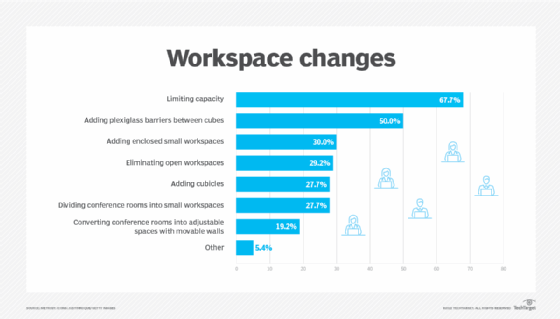
kras99 - stock.adobe.com
As large-room video conferencing ebbs, firms gird for future
As companies evaluate return-to-office strategies, they are also taking a look at the role video conferencing will play when they reassess how meeting rooms should be designed.
The office has undergone a tremendous transformation over the past two years. Not only has its role changed -- so has its configuration, especially in meeting rooms.
According to Metrigy's "Unified Communications Management and Endpoints: 2021-22" study of some 400 companies worldwide, only 20.5% of participants planned to have all employees return to the office on a full-time basis. The report also found that almost 28% of respondents had started the process of evaluating potential savings from reducing the size and number of their offices.
Redefining the purpose of the office
For those bringing employees back to the office, either full- or part-time, the first requirement is to determine the purpose of the office and large-room video conferencing. For roughly 62% of research participants, offices will exist as they did before the COVID-19 pandemic, serving as a place for both individual work and group meetings. However, about 35% see offices evolving, either to become primarily places where remote workers go to meet or where employees work individually but do not have group meetings.
Concerns about COVID-19, meanwhile, continue to push organizations to limit the number of individuals having close contact in meeting rooms. As a result, 21% of companies said remote meetings will remain the norm.
As density and contact worries mount, about a third of companies are making physical changes to their offices, often driven by facilities and HR teams. These include setting capacity limits, creating physical barriers between employees, constructing small, phone booth-style meeting rooms for a limited number of participants and splitting large meeting spaces into smaller rooms.

Video conferencing underpins these shifts. Despite concerns that video fatigue would overwhelm employees, nearly 45% of companies saw video utilization increase in the second half of 2021, and almost 85% said video is a critical or important technology supporting company operations. Moreover, some 55% of organizations are increasing their deployments of video conferencing systems to meeting rooms and spaces.
Going forward, those responsible for video collaboration in their organization should plan for the following:
- Offer flexibility in workspace design and video conferencing equipment provisioning. While large-room video conferencing will still exist, many companies will increase provisioning of smaller meeting spaces. Video is now ubiquitous, meaning that employees need access to high-quality video experiences, regardless of meeting location.
- Understand application use. Almost half of companies support more than one video app. While the ideal goal is to enable employees to easily walk into a room and click on a screen to launch a meeting, that may not be possible if the gathering is happening using an app that isn't optimized for the room. Consider approaches that provide flexibility to enable employees to use video conferencing room systems, regardless of the meeting software.
- Realize virtual collaboration has changed. The last two years saw a rapid rise in virtual whiteboard and ideation apps. Companies simply can't go back to the time when remote participants were audio-only, which meant they couldn't see the in-room dry-erase whiteboard. Now, remote participants are likely to use these virtual apps to flesh out ideas. In-room participants who lack large touchscreens are at risk of not being able to fully engage in collaborative experiences, including chat, Q&A and polling.
- Consider digital signage. Make sure it's easy for employees to find available rooms, either through space management apps or through small displays that provide a visual indication of room status, such as red for in-use and green for available.
Finally, ensure IT can manage whatever in-room approaches you deploy. Take advantage of rapidly emerging software tools for room provisioning, software updates and health checks to make it easy for IT to respond to any employee issues.
Office and large-room video conferencing strategies will be in flux as companies determine their return-to-office and purpose-of-office plans. Consider any plan to be an ongoing process rather than a point-in-time solution. Modify your approach as your environment and requirements change.







